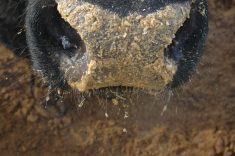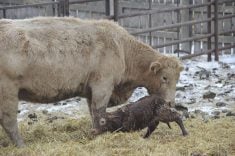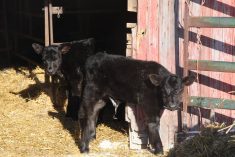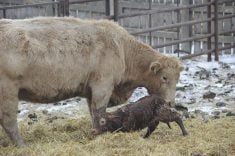Many calves that develop the disease didn’t get enough colostrum, but dirty environments can overwhelm their immunity
Calves can develop infection when bacteria or toxins enter the bloodstream, and some of those toxic bacteria gain entrance through the navel stump or the gastro-intestinal tract.
Any blood-borne infection can become life-threatening if the bacteria or toxins damage vital organs. The infection may localize, create internal abscesses or settle in the joints, causing joint ill.
Dr. Steve Hendrick of the Coaldale Veterinary Clinic in Coaldale, Alta., says calves are born without antibodies to protect them from disease.
“They obtain the necessary antibodies from the colostrum. Many people don’t realize how critical this is, to make sure the newborn calf has adequate colostrum.
Read Also

Quebec pork company calls for transparency around gene-edited pigs
Quebec-based pork company duBreton is calling for transparency around meats from gene-edited pigs on concerns that a lack of mandatory labelling will confuse consumers, and dilute certification claims. The organic sector is also calling for labelling rules.
“Ideally it should come from the dam because she has been in the environment the calf will be born into, and she has been exposed to the pathogens her calf will encounter, and has the necessary antibodies in her colostrum.
“It’s fine to use a commercial supplement if you have no other choice … and you don’t have any frozen colostrum for emergencies. But the colostrum harvested to create a commercial product comes from a different environment. It’s a good Band-Aid, but there is a lot of value in using colostrum from your own cows.
“Many of the calves that develop septicemia are those that didn’t get enough antibody protection from colostrum.”
Even with colostrum, calves’ immunities can be overwhelmed if they are born into a filthy environment. They can develop a navel infection or ingest pathogens before they have adequate colostrum.
“Bedding is always a good prevention against navel infection, if cows are confined rather than calving out on large grass pastures,” Hendrick says.
“A common entry site for pathogens is the umbilicus at birth because this opening is moist and accessible. We also see calves born in dirty conditions that have to suckle a dirty udder or nuzzle around the cow’s dirty legs and flanks trying to find the udder.
“This increases the number of pathogens the calf will ingest, and the open gut lining that enables the large molecules of antibodies to pass through and be absorbed also allows pathogens to pass through. If the calf ingested some E. coli or other harmful bacteria from the manure and mud, there is high risk for those to be absorbed into the body through the gut.”
Dirty conditions also allow more bacteria to contact the calf’s umbilical stump, increasing the risk of septicemia. However, infections can get into the bloodstream from nearly any location of the body.
With septicemia, also called blood poisoning, prompt treatment is vital because internal organs or joints may otherwise be damaged.
Signs of septicemia may include weakness, depression and dehydration. The calf may be unable to get up and have pale gums, cold feet, cold ears and rapid heart rate.
If the calf is young and sick with swollen joints, check the navel for signs of infection such as swelling, heat, a thick umbilicus or pus discharge.
Work with a veterinarian when early signs are noticed because earlier treatment brings a better chance of halting the infection and saving the calf.
If a very young calf is depressed but doesn’t have a swollen navel, it may be an E. coli septicemia from ingested bacteria. A veterinarian can advise on the proper course of antibiotics.
“Septicemia infections tend to filter out into some of the smaller blood vessels like the capillaries, particularly in the joints or where the bones are growing,” says Hendrick.
“This may result in a chronic arthritis. It’s difficult to get enough antibiotic into those areas. You might be able to save the calf’s life but he ends up crippled or lame.
“There are also a lot of capillary beds around the brain and other organs where the bacteria may filter out and cause problems with the brain, kidneys, liver or lungs. If the calf was bright and active at birth and is now becoming dull and dopey, it may be due to septicemia. One of the outcomes could be meningitis or a brain abscess, as well as joint infections.”
Hendrick says some producers who have had problems in the past will give every calf a long-acting antibiotic at birth but this is not recommended.
Some calves can recover from septicemia but bacteria in the bloodstream cause permanent joint damage.
“Some calves heal OK but some have enough damage to the growth plates that they end up crippled,” says Hendrick.
In addition to systemic antibiotics, a calf with swollen, hot and sore joints may need anti-inflammatory medication and sometimes this allows better healing.

















